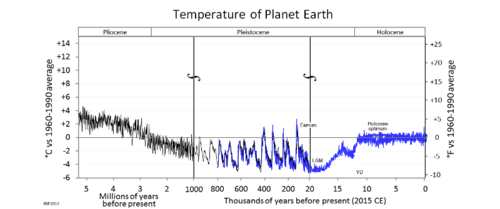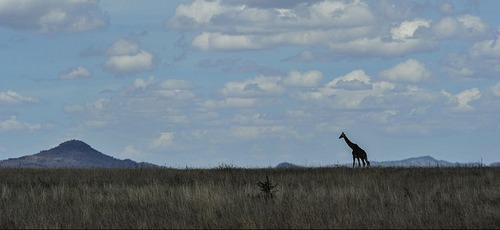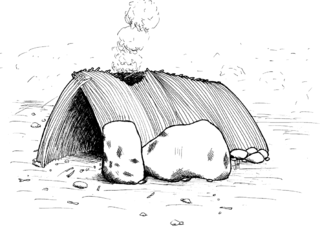7.8 气候在人类进化中的作用
章节大纲
-
"To Infinity and Beyond!"
::"无穷无尽"This quote was made famous by Buzz Lightyear, a cartoon astronaut from the movie Toy Story , but it illustrates something important about the human psyche. Humans seem to have a need to find new and challenging locations to live in (or at least visit!), including outer space. The astronaut pictured above is a different Buzz — Buzz Aldrin — and he’s shown here walking on the lunar surface. Humankind's ability to adapt to all kinds of environments — even the airless, low-gravity surface of the Moon — is a hallmark of modern humans and their recent ancestors . Homo sapiens is arguably the most adaptable that ever evolved.
::这段引言由电影《玩具故事》的卡通宇航员巴斯·光年出名,但其中说明了人类精神的重要内容。 人类似乎需要找到新的、具有挑战性的地点,包括外层空间。 上面所描绘的宇航员是另一个巴斯 — — 巴斯·阿尔德林 — — 他在这里在月球表面行走。 人类适应各种环境的能力 — — 甚至月球无空气、低重力表面 — — 是现代人类及其近代祖先的标志。 人猿可以说是史无前例的最适应性。Climatic Change and Adaptation
::气候变化和适应Many different types of evidence show that the span of time during which humans and their hominin ancestors evolved was one of the most climatically erratic periods in Earth’s history. Starting about five million years ago, there was a steady decline in temperature and precipitation worldwide. More recently, there have been large fluctuations in temperature and precipitation, with wild swings between hot and cold, wet and dry. Worldwide fluctuations in temperature over this period are shown in the graph . Notice how extreme the variations become between about 800 thousand and 20 thousand years ago.
::许多不同类型的证据表明,人类及其荷米宁祖先的进化时间是地球历史上气候最不稳定的时期之一。 从五百万年前开始,全球气温和降水量稳步下降。 最近,气温和降水量出现了大幅波动,在热、冷、湿、干之间发生狂风波动。 图表中显示了这一时期全球气温的波动。 注意这些变化在八万至二万年前的极端变化。This graph shows an overall cooling trend in Earth's climate over the past five million years. Especially large oscillations in temperature occurred from about 800 thousand to 20 thousand years ago.
::本图显示了过去五百万年中地球气候的总体冷却趋势,特别是从大约八万至二万年前的温度波动。During hominin evolution, climatic shifts led to equally great shifts in vegetation. For example, as the climate became cooler and drier in East Africa starting around five million years ago, early hominin habitats changed from forests to dry grasslands, called savannas. This led to changes in the types of foods that hominins relied on, the density of food sources available to them, and the predator and parasite species they faced — among many other changes.
::例如,从500万年前开始,东非的气候变得更加凉爽和干燥,早期的人类栖息地从森林转变为干旱草原,称为热带草原,这导致人类赖以生存的粮食种类、粮食来源的密度以及它们所面临的食肉动物和寄生虫物种——除其他变化外——发生变化。Whenever there is a change in an animal’s environment, there are a number of possible options for dealing with the change. One option is to move to a new area where the preferred environmental conditions can be found. I f the climate in an area gets colder, for example, an animal species may be able to move closer to the equator in order to continue to live in its favored habitat. If moving to track a favored habitat is not possible, a species may be able to undergo biological evolution to adapt to the new environment. B iological evolution, however, depends on favorable occurring, and this is a matter of chance. The process of biological evolution may also occur too slowly for new traits to evolve in time to deal with a changing environment. If neither of these two options — moving or evolving — works out, then the species may go extinct.
::当动物环境发生变化时,就有一些可能的办法来应对变化。一个选择是转移到一个可以找到首选环境条件的新区域。例如,如果一个区域的气候变冷,动物物种也许能够更靠近赤道地区,以便继续生活在它所偏好的生境中。如果移动去追踪一个有利的生境是不可能的,一个物种也许能够进行生物进化以适应新的环境。然而,生物进化取决于有利的发生,这是一个机会问题。生物进化过程也可能发生太慢,新的特征在时间上会随着环境的变化而演变。 如果这两种选择 — — 移动或演变 — — 都不能奏效,那么物种就可能灭绝。There is one other option for dealing with environmental change, which is to become more adaptable. Being flexible about where you can live and what you can eat, for example, may allow you to survive changing climates and shifting habitats without migrating or changing genetically. The ability to adjust to a variety of different environments seems to be the option taken by humans and their hominin ancestors. Because of the volatile times in which they evolved, the ability to adapt to changing conditions may have been more strongly selected for than any other characteristic.
::处理环境变化还有另外一种选择,即更适应性。比如,在可以生活的地方和可以吃的东西上保持灵活,也许可以让你在不迁移或改变基因的情况下在不断变化的气候和生境中生存下去。 适应不同环境的能力似乎是人类及其祖先的选择。 由于他们进化的时代变化不定,因此适应变化条件的能力可能比任何其他特征都更被选择。Hypotheses About Climate and Human Evolution
::关于气候和人类进化的假设The idea that humans evolved to become more variable in response to climatic and other environmental changes is relatively new. It runs counter to the long-held view that humans evolved several major adaptations for one particular type of habitat: the East African savanna (like the one pictured ). According to the savanna hypothesis , certain human traits — such as upright bipedal walking — were associated with the shrinking of forests and the spread of savannas. Upright bipedalism has a number of potential advantages in a savanna habitat. It allows one to see predators over tall grasses and reduces the heat load on the body because of direct sun exposure. Bipedalism is also the most efficient way to travel long distances over the ground.
::人类随着气候和其他环境变化而演变成为变数较多的观念是相对新的,与人类为一种特定类型的生境(东非热带草原(如所描绘的热带草原))作出若干重大调整的长期观点背道而驰。根据热带草原的假设,某些人类特征(如直立双足散步)与森林萎缩和热带草原的蔓延有关。在热带草原生境中,右翼双脚主义具有若干潜在优势。它使人们能够看到高草上的掠食肉动物,并由于直接暴露太阳而减少身体的热量。双脚主义也是在地面上长途旅行的最有效方式。This photo was taken in Serengeti National park, a modern savanna habitat in Tanzania (East Africa).
::这张照片是在坦桑尼亚(东非)现代热带草原生境塞伦盖蒂国家公园拍摄的。The newer view — that we evolved greater adaptability in response to climate change — has been dubbed the variability-selection hypothesis . According to this hypothesis, early hominins and their descendants did not become more specialized for a particular habitat. Instead, their evolution was shaped by climatic instability and changing environments. Rather than becoming better suited to savannas, we became better able to cope with a diversity of habitats. This happened through a process called variability selection , which is for structures and traits can be used to adapt to a variety of environments.
::较新的观点——即我们随着气候变化而发展了更大的适应能力——被称作变异选择假设,根据这一假设,早期的人类元素及其后代并没有对某一特定生境变得更为专业化,相反,它们的演变是由气候不稳定和变化环境所决定的,我们不是更适合热带草原,而是更有能力应付生境的多样性,这通过一种称为变异选择的过程发生,即结构和特性可以用来适应各种环境。Evidence for Adaptability
::可调适性的证据If the variability-selection hypothesis is correct, we would expect early hominins to have lived in a diversity of habitats, and not just in savannas. The provides evidence that this was indeed the case. For example, of the earliest hominins ( Australopithecus anamensis and Australopithecus afarensis ) have been found in areas that would have included both grasslands and woodlands. Fossils of these early species show a mix of traits that adapted them to live in both types of habitats. They had hips and legs that made them well adapted for walking on the ground. They had feet that were suited for both walking on the ground and climbing in trees. They had long arms and long fingers that made them well adapted for arboreal climbing.
::如果选择变化的假设是正确的,我们预计早期的动物群将生活在多种生境中,而不仅仅是热带草原。这证明了事实确实如此。例如,在既包括草原也包括林地的地区发现了最早的动物群(Australobithecus anaamensis和Australopithecus afarensis),这些早期物种的产物混合了各种特征,使它们适应于两种类型的生境中的生活。它们的臀部和腿适合在地面上行走。它们的脚既适合在地面上行走,又适合爬树。它们有长的手臂和长的手指,使它们适应异常的攀爬。The widespread geographic distribution of Homo erectus provides evidence that these early humans were even more adaptable, and could thrive in a greater diversity of habitats. Not long after evolving in Africa, Homo erectus left that continent and soon was living in several different locations in Asia. Some of these locations were relatively far north. They were considerably cooler than Home erectus' tropical African homeland. Some of the habitats associated with Homo erectus sites in Asia included grasslands, bushlands, forests, and coastal environments. In each habitat, Homo erectus would have had to adjust to different climatic conditions and new plant and animal species.
::智人勃起的地理分布很广,证明这些早期人类更适应性更强,可以在更多样化的生境中蓬勃发展。在非洲演变不久后,智人勃起离开该大陆,很快居住在亚洲的几个不同地点。其中一些地点相对而言是北边的,比家园勃起的热带非洲家园冷得多。亚洲一些与智人勃起点有关的生境包括草原、灌木地、森林和沿海环境。在每一个生境中,智人勃起者必须适应不同的气候条件以及新的动植物物种。Selection for Encephalization
::选择用于脑化What structures and traits were selected for that made humans and their ancestors so adaptable? Probably the most important structure was a bigger, smarter brain . Encephalization — or the evolutionary enlargement of the brain relative to body size — increased our level of intelligence. This, in turn, allowed us to rely increasingly on culture and technology. The more intelligent we became, the better able we were to invent and learn new behaviors, including abstract thought, language, social interactions, planning, problem solving, tool making, controlling fire, making shelters (see sketch ), and m ore . With our great intelligence and malleable behaviors, we could change or exploit many different environments to meet our needs.
::人类及其祖先之所以能够如此适应,选择了哪些结构和特征?也许最重要的结构是更大的、更聪明的大脑。 人脑化,或大脑相对于身体体积的进化扩张,提高了我们的智力水平。 这反过来又让我们越来越依赖文化和技术。 我们越聪明,我们就越有能力发明和学习新的行为,包括抽象思想、语言、社会互动、规划、解决问题、工具制造、控制火灾、建造庇护所(见草图 ) , 以及更多。有了我们伟大的智慧和可移动的行为,我们可以改变或利用许多不同的环境来满足我们的需求。This sketch shows a wood and stone shelter with a hearth fire burning inside. The sketch is based on artifacts from an archeological site associated with hominins in southern France about 380 thousand years ago. Building shelters and using fire were behavioral ways our ancestors adapted to a cold climate.
::这幅草图显示了一个木头和石头的掩蔽所,里面燃烧着一个壁炉。 草图基于大约38万年前法国南部一个与人迹有关的考古遗址的文物。 建造掩蔽所和使用火是我们祖先适应寒冷气候的行为方式。The table shows the encephalization quotient for major hominin species. The encephalization quotient is a measure of the size of the brain that corrects for body size. A bigger body needs a bigger brain, so a bigger brain does not always correlate with an increase in "computing power" and intelligence. The encephalization quotient was developed so that comparisons of brain size could be made for species that differ in body size. The larger the encephalization quotient, the greater the evolutionary enlargement of the brain relative to body size.
::表格显示了主要荷明物种的脑部化商数。 脑部化商数是衡量大脑大小的尺度,可以校正身体大小。 更大的身体需要一个更大的大脑, 所以更大的大脑并不总是与“ 计算能力” 和智能的增加相关。 脑部化商数的开发是为了比较身体大小不同的物种的大脑大小。 脑部化商数越大, 大脑相对于身体大小的进化扩张越大。Encephalization Quotient in Selected Hominins Species Date Range Encephalization Quotient Australopithecus afarensis 3.9-3.0 million years ago 2.50
Homo habilis 1.9-1.6 million years ago 3.60
Homo erectus 1.8-0.2 million years ago 3.61
Homo heidelbergensis 750-250 thousand years ago 5.26
Homo neanderthalensis 250-30 thousand years ago 5.50
Homo sapiens 200 thousand years ago to present 5.80
The degree to which encephalization occurred during human evolution is phenomenal. Brain size increased slowly but steadily from about five million years ago until about 800 thousand years ago. Then, the rate of increase in brain size became very rapid. It is probably no coincidence that this period of very rapid brain growth was also characterized by greater fluctuations in climate than any other time in hominin evolution.
::人类进化过程中脑细胞化的程度是惊人的。 大脑体积缓慢但稳步地增长,从500万年前的大约500万年到80万年前的大约80万年前。 然后,大脑体积的增长速度变得非常迅速。 很可能并非巧合的是,这个非常快速的大脑增长时期的气候波动也比荷米宁进化过程中的任何时候都要大。Feature: Reliable Sources
::特征:可靠来源Perhaps no hominins had a more difficult and variable climate to cope with than the European Neanderthals during the last ice age. Did failure to adapt to the harsh and rapidly oscillating climate of the ice age cause these archaic humans to go extinct? Or did with modern human moving into Western Europe result in the extinction of the Neanderthals? As more data accumulate about both climate and the Neanderthals (especially Neanderthal DNA), the picture becomes increasingly complex.
::也许没有人会比欧洲尼安德特人(欧洲尼安德特人)在上一个冰河时代更难以应对和多变的气候。 没有适应冰河时代严酷和迅速波动的气候导致这些古老人类灭绝吗? 或者随着现代人类进入西欧而导致尼安德特人灭绝? 随着更多关于气候和尼安德特人(特别是尼安德特人DNA)的数据积累,情况变得日益复杂。A study published in 2012 in the journal Molecular Biology and Evolution suggests that Western European Neanderthal populations may have been drastically reduced in size about 50 thousand years ago, most likely due to a short period of extreme cold. T hey went through a population bottleneck. When modern humans arrived in Western Europe a few thousand years later, the Neanderthals may have already been on the verge of extinction. They would have been far fewer in number and also less genetically diverse than they were before the bottleneck occurred. Both factors would have made them less resilient to modern human competition and further climatic change.
::2012年出版的《分子生物学和进化》杂志《分子生物学和进化》的研究表明,西欧尼安德特人人口在5万年前可能已经大幅下降,这很可能是由于短暂的极端寒冷时期。 他们经历了人口瓶颈。 当现代人类在几千年后抵达西欧时,尼安德特人可能已经濒临灭绝。 他们的人数可能比瓶颈发生前要少得多,基因多样性也更少。 这两种因素都会使他们对现代人类竞争和进一步气候变化的适应力更弱。Do a W eb search to identify the most up-to-date research on the role of climate and modern human populations in the extinction of the Neanderthals in Western Europe. You may use secondary sources if you judge them to be reliable, but try to use only those that are based directly on primary sources, such as the journal article cited above. Summarize what you learn in a concise paragraph, including any questions raised by the latest research findings.
::进行网络搜索, 以确定关于气候和现代人类人口在西欧尼安德特人灭绝中作用的最新研究。 如果您判断它们可靠, 您可以使用二手来源, 但只试图使用直接基于原始来源的源头, 如上面引用的日记文章。 总结您在简洁段落中所学到的东西, 包括最新研究结果所提出的任何问题 。Summary
::摘要-
Hominins evolved during one of the most climatically erratic periods in Earth's history. Climatic shifts led to equally great shifts in vegetation and other environmental factors. For example,
during the evolution of early hominins,
cooling and drying led to a shift from forests to savannas in East Africa.
::Hominins是在地球历史上气候最不稳定的时期之一演变而来的,气候变迁也导致植被和其他环境因素发生同样巨大的变化,例如,在早期的Homminins演化过程中,冷却和干燥导致东非从森林向热带草原的转变。 -
Three common ways that animals may respond to climate change are: moving to track their preferred climate, adapting specializations to the new climate through biological evolution, or going extinct.
::动物可能应对气候变化的三种常见方式是:努力跟踪其首选气候,通过生物进化使专业化适应新气候,或灭绝。 -
According to the long-held savanna hypothesis, early hominins evolved specializations to a savanna habitat as a response to climate change. This is supported by logical arguments for the advantages of early hominin traits, such as bipedalism in a savanna habitat.
::根据长期持有的热带草原假说,早期的Hominins(Hominins)发展成热带草原栖息地的专业化,以应对气候变化。 早期的Hominin特征(如热带草原栖息地中的双足主义)的优点的逻辑论据支持了这一点。 -
An alternative hypothesis — called the variability-selection hypothesis — proposes that hominins evolved the ability to be more adaptable in response to climate change. This hypothesis is consistent with fossil evidence of hominins living in diverse habitats.
::另一种假设,即所谓的变异选择假设,提出恒星进化成更适应气候变化的能力,这一假设与生活在不同生境的恒星的化石证据是一致的。 -
Encephalization — or the evolutionary enlargement of the brain relative to body size — occurred throughout hominin evolution, and it occurred most rapidly when climate was most
variable
. A bigger brain would have increased our level of intelligence and our ability to use behavioral adaptations to deal with climate change.
::在整个荷米宁进化过程中,脑土化 — — 即相对于身体大小而言,大脑的进化扩张 — — 都发生在荷米宁进化过程中,当气候变化最大时,这种进化最为迅速。 更大的大脑本可以提高我们的智力水平和运用行为适应来应对气候变化的能力。 -
Encephalization can be compared across species that differ in body size by comparing the encephalization quotients, because the encephalization quotient corrects for differences in body size.
::可以通过比较脑电荷商数比较体积不同的物种,比较体积不同的物种,以比较脑电荷商数,因为脑电荷商数纠正体体大小的差异。
Review
::回顾1. Summarize the climatic changes that occurred during hominin evolution.
::1. 概述在荷米宁变化期间发生的气候变化。2. A s hominins evolved, h ow did climate change affect other environmental factors?
::2. 随着霍明斯的演变,气候变化如何影响其他环境因素?3. Identify three common ways that animal species may respond to climate change.
::3. 确定动物物种应对气候变化的三种共同方式。4. Compare and contrast the savanna and variability-selection hypotheses for hominin evolution.
::4. 比较和比较热带稀树草原和可变性选择的恒民进化假设。5. Define encephalization.
::5. 界定脑电图化的定义。6. What is the encephalization quotient? Why was it developed?
::6. 脑电算商数是什么?为什么是发展起来的?7. Explain the relationship between encephalization and behavioral adaptability of hominins in response to climate change.
::7. 解释女性脑电离症与因气候变化而适应其行为之间的关系。8. What types of evidence do you think are needed to determine the encephalization quotient for extinct species of hominins?
::8. 你认为需要哪些类型的证据来确定已灭绝的人类物种的脑细胞化商数?9. Which of the below statements most accurately describes what a smaller encephalization quotient indicates?
::9. 以下哪些说法最准确地描述了较小的脑电算商数表示什么?a. a smaller relative brain size compared to body size
::a. 与身体大小相比,大脑相对规模较小b. a brain that is smaller than that of early humans
::b. 大脑小于早期人类的大脑c. a brain with small regions dedicated to complex reasoning
::c. 与小区域专门进行复杂推理的大脑;d. a small brain resulting from a small body
::d. 由小身体产生的小大脑10. Name one trait that hominins evolved that is advantageous for a life on the ground in grasslands.
::10. 指出Homminins演变成的有利于草地上生活的一个特征。11. Name one trait in primates that is advantageous for a life in trees.
::11. 指出灵长类中有利于树木生活的一个特征。12. True or False: Homo erectus lived exclusively in savannas.
::12. 真实或假:人造人只住在热带草原上。13. True or False: Brain size in hominins increased most rapidly prior to 800 thousand years ago.
::13. 真实或假:在80万年前,女性的大脑规模增长最快。14. Why might language be advantageous to hominins living in a changing environment?
::14. 为什么语言会有利于生活在变化环境中的居家居民?Explore More
::探索更多Professor Hill of Yale University is interested in the whole range of human evolution, but particularly in the environmental and ecological context. Learn more here:
::耶鲁大学Hill教授关心人类的演变,但特别关心环境和生态方面。 -
Hominins evolved during one of the most climatically erratic periods in Earth's history. Climatic shifts led to equally great shifts in vegetation and other environmental factors. For example,
during the evolution of early hominins,
cooling and drying led to a shift from forests to savannas in East Africa.



